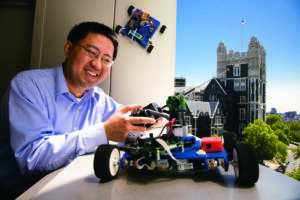Infrastructure integrity is at a critical point as American building and bridges built in the 1960’s are nearing their end of life. This is crucial, especially for bridges as their life expectancy is 50 years, according to Dr. Jizhong Xiao, Professor of Electrical Engineering and Director of the Robotics Lab at City College. Currently, an inspector utilizes a device like a ground penetrating radar (GPR) is to inspect infrastructure. Scaffolding can also be built for inspectors to reach difficult-to-access locations.
Dr. Xiao is also cofounder of InnovBot, a company building robots that can aid in inspection. Utilizing suction and dynamic attraction, a robot can stick onto walls and assess areas where regular robots cannot, like the vertical surfaces of dams, bridges, and piers. “They can scan the surface with a camera for surface flaws or a GPR for subsurface defects.” This can lead to an increase in worker safety, reducing costs and eliminating the need for scaffolding and traffic disruptions.

Our robots can improve inspection job performance 10-fold compared to manual inspection. We strive to be the world leader in vertical mobility and infrastructure inspection, providing robotic solutions for infrastructure inspection and maintenance. – Dr. Xiao, Cofounder and CEO, InnovBot
City College alumnus Diar Sanakov (BS Mechanical Engineering ’20), a transfer from BMCC after completing his Associated Degree in Physics, is one of four employees at InnovBot. After spending his senior year as a research assistant in Dr. Xiao’s robotics laboratory, he was offered a job upon graduating. “I wasn’t sure if I wanted to head towards academia or industry, but I knew wanted to do something innovative.”
 Sanakov serves two roles within the company, mechanical engineer, and Principal Investigator (PI) for the National Science Foundation’s Small Business Innovation Research (SBIR) grant. As the sole mechanical engineer, his daily tasks include conceptualizing to refining the final product. This includes working on calculations, simulations, modeling, prototyping, and manufacturing. As a PI, he writes executive summaries, bill of materials and progress reports necessary for the grant.
Sanakov serves two roles within the company, mechanical engineer, and Principal Investigator (PI) for the National Science Foundation’s Small Business Innovation Research (SBIR) grant. As the sole mechanical engineer, his daily tasks include conceptualizing to refining the final product. This includes working on calculations, simulations, modeling, prototyping, and manufacturing. As a PI, he writes executive summaries, bill of materials and progress reports necessary for the grant.
Although he is the sole mechanical engineer alongside other electrical engineers, there aren’t communication issues between colleagues. “In my strict opinion, an engineer has to be versatile, have proper communication skills to understand and comprehend with your colleagues in another field.”

The company completed Phase I funding that allows for research and development before Phase II, when InnovBot can reiterate and refine prototypes to bring them to market. In the future, the company might add robotic tools to their portfolio that perform maintenance operations like sealing cracks in concrete and cleaning windows on high rise buildings.
CUNY, NSF and other agencies are encouraging entrepreneurship to transfer lab innovations to product. They funded you to do research, not only to publish the papers, but to have a broader impact. – Dr. Xiao

Edgar Llivisupa is a journalist based in New York who joined the RICC in May 2021. Currently a Journalism and Spanish major at Baruch College he has covered business, science, culture and transit, in addition to living in Spain for two years to improve his Spanish proficiency.